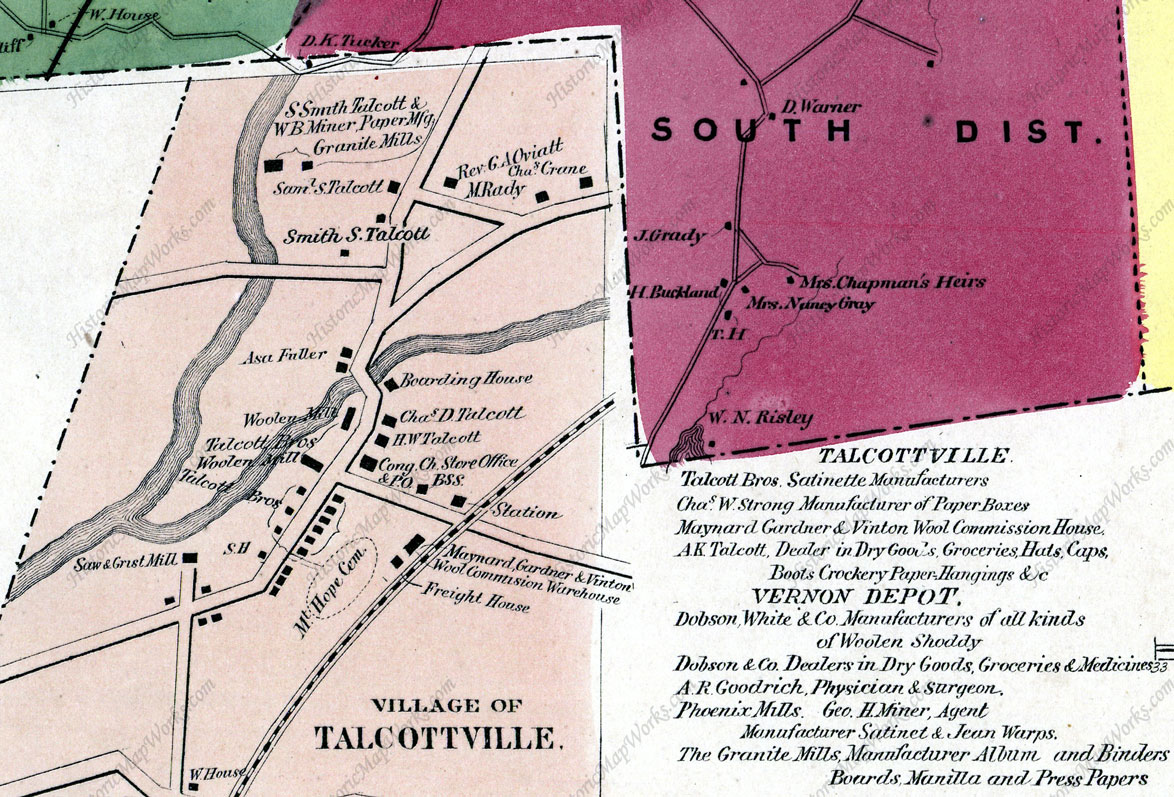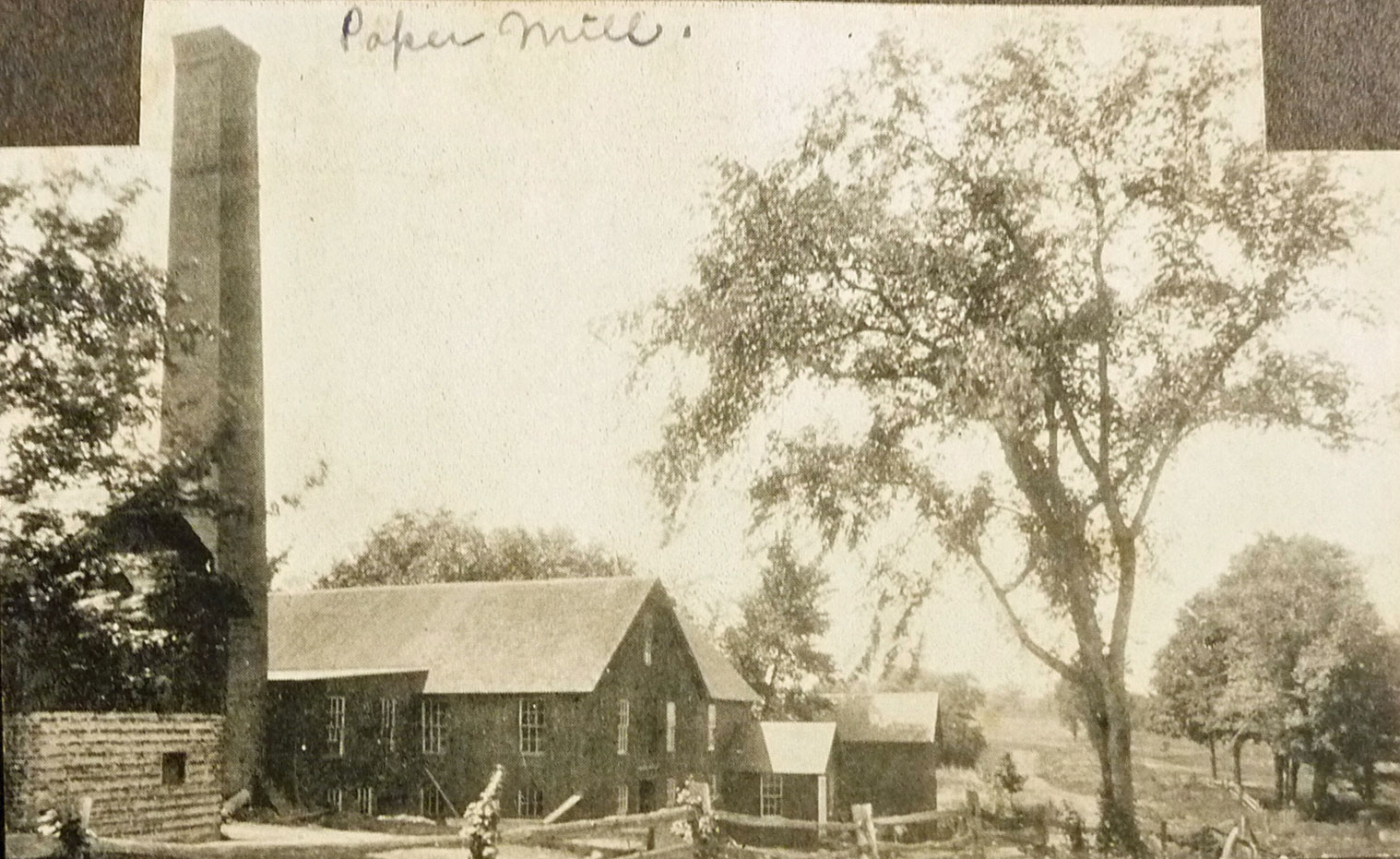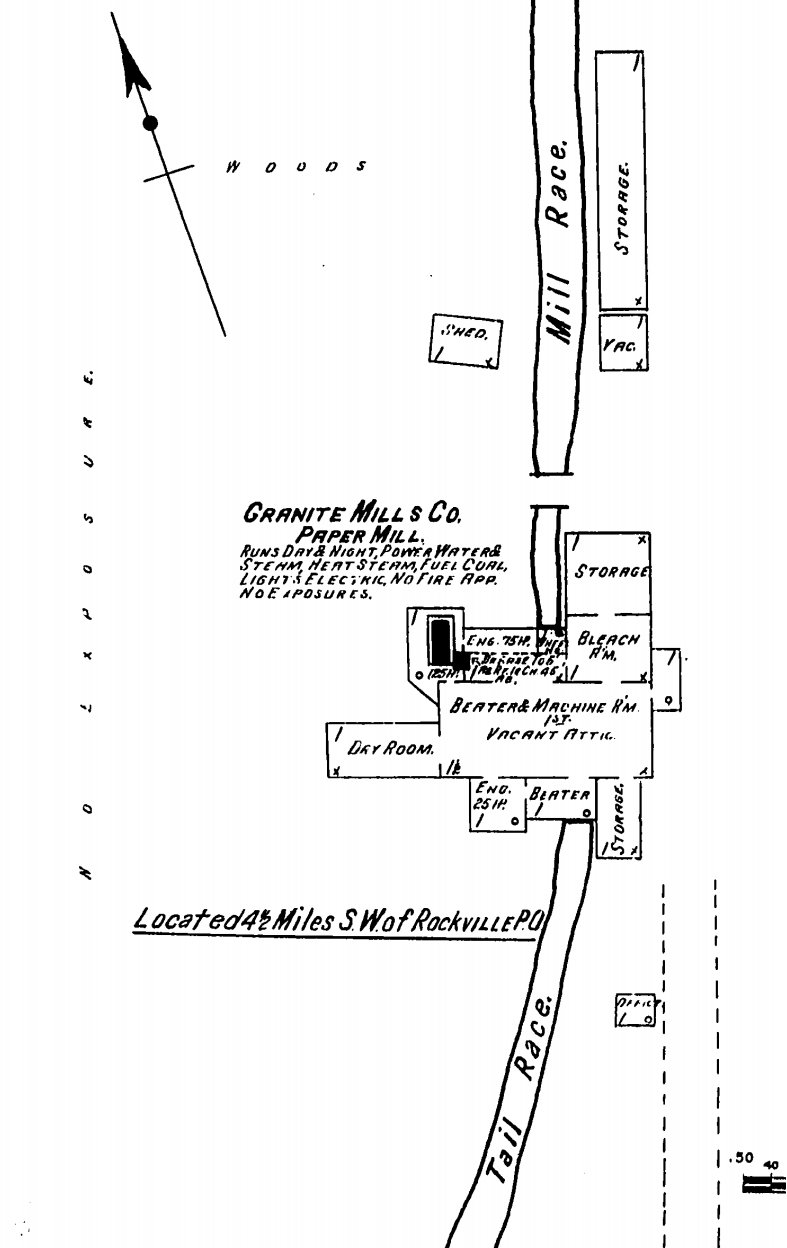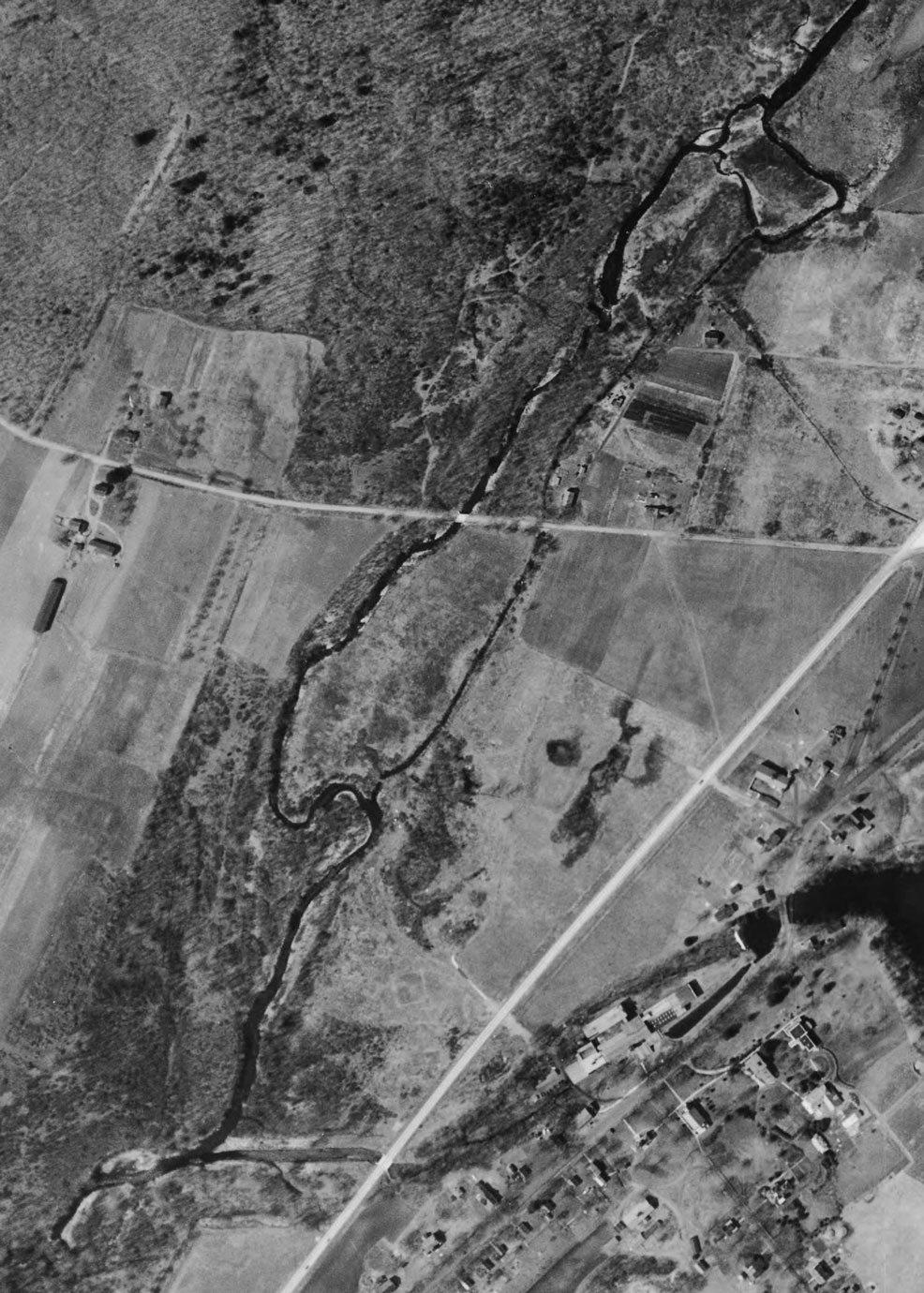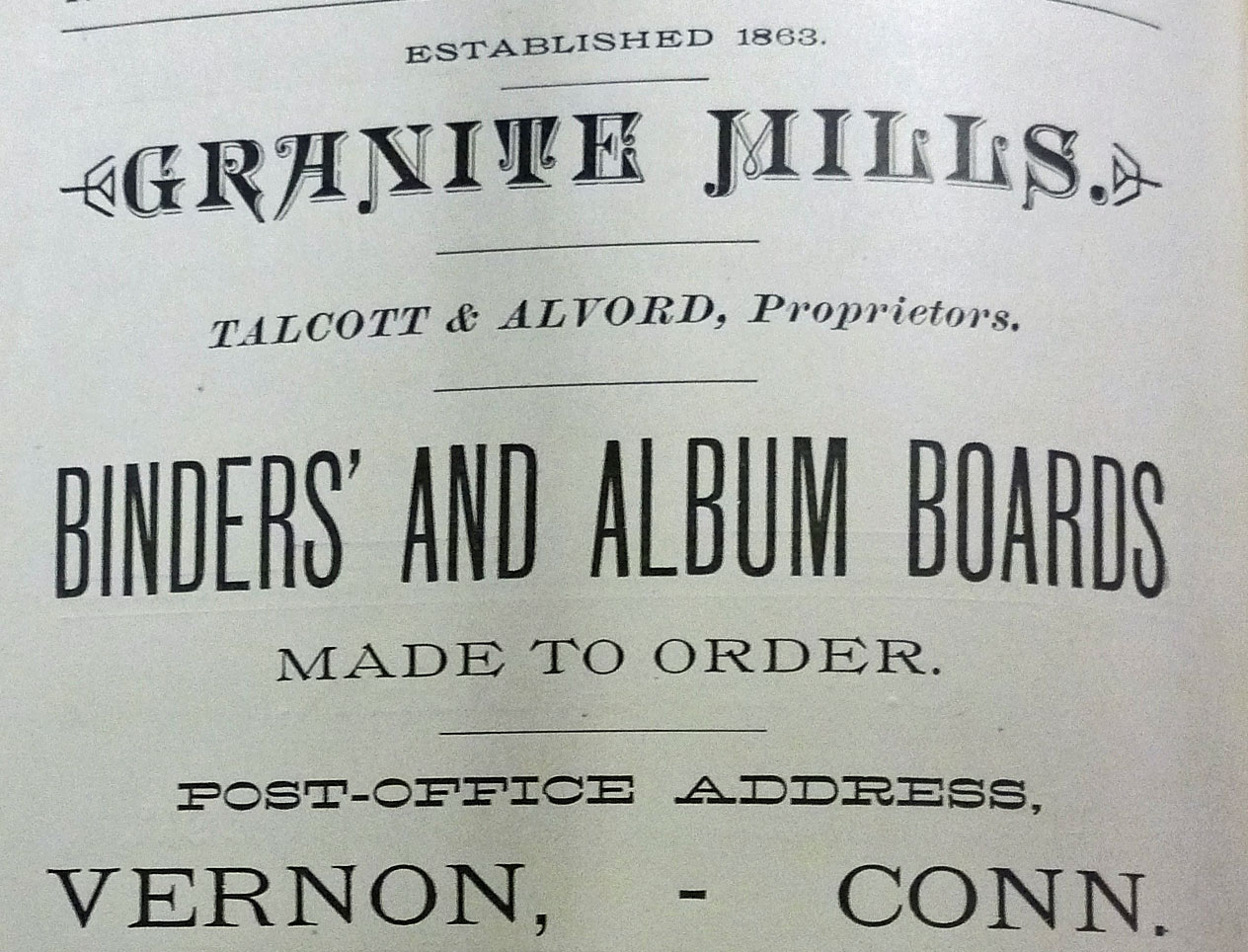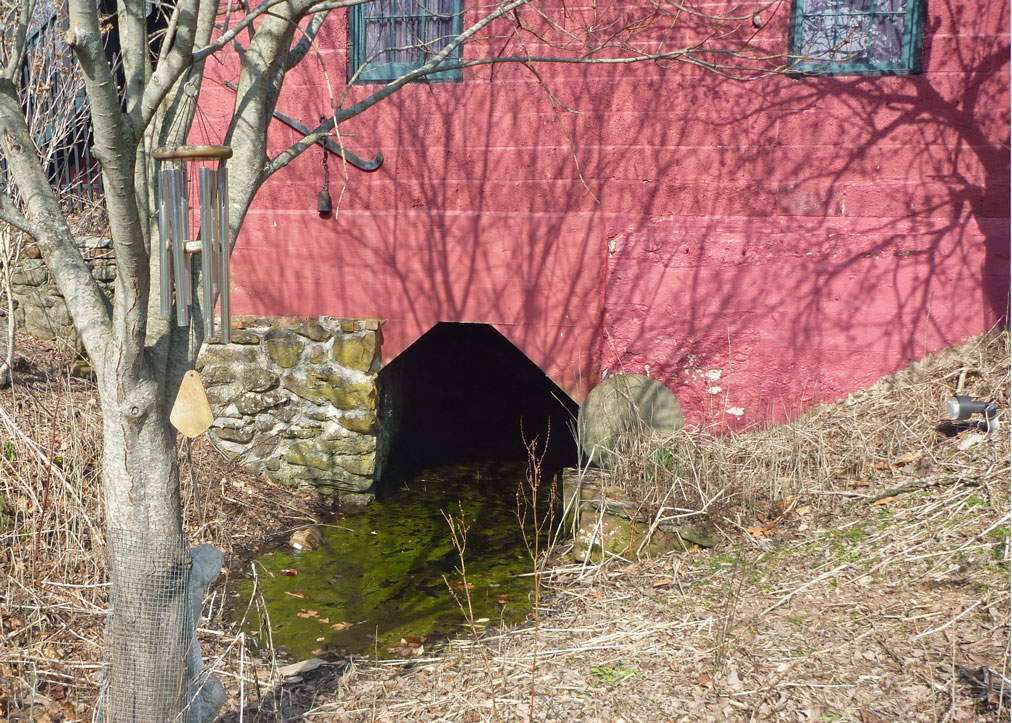 |
| Home | Geography | History | Biology | Recreation | News | Resources |
| Timeline | Narrative | Events | Places | People |
Granite Mills (Circa 1850-1912)
The Granite Mills, located on the Hockanum River just above Kelly Road, was a paper mill manufacturing albums, binders, boards, manilla and press papers. Ownership changed many times. It was also known as the Granite Paper Mills and the Talcottville Paper Mill. An oil mill was at this location before 1838. The paper mill was established after a fire in 1863. It burned in 1870 and again in 1881, being rebuilt each time. In addition to the main building there were store houses, three large tenement houses, sheds, offices, etc., all located on a plot of about six acres. The mill burned a final time on August 1, 1912 and was not rebuilt. An article in Cole describes the business in 1888: "The material used at this mill is exclusively old paper, which is purchased in the large cities, and is received in bales weighing from four hundred to one thousand pounds each. The company employs about fifteen hands. The average weight of paper product per twenty-four hours is about three tons, and in times of business activity twenty-five tons per week." "The mill is run continuously, this being necessitated by the nature of the materials used, and the extra labor required to prepare the pulp after being allowed to remain idle for a few hours. The product of this mill finds a ready market in New York, Boston and Philadelphia, and the fact that the mill has plenty of business is an indication that it is successfully managed." Above the mill on the Hockanum River was a dam and mill pond. From there a race on the east side of the river led to the mill. The tail race did not rejoin the Hockanum River until about where I-84 is today. At the time the mill was in operation there was no shopping center, circle or highway. Construction of the circle in the early 1930's and the highway in the 1940's erased roads to the mills. When Tri-City Plaza was built in 1963 it cut off access to the area and the Granite Mills were forgotten. Locating The Mill
The Granite Mills are mentioned in a number of publications and directories without clearly indicating their location. Early city directories list Vernon Depot, which would seem to place it on the Tankerhoosen River. Later directories put it in Talcottville. There is also evidence of mills on the Hockanum River near the Mansions. The 1853 Woodford Map shows a Talcott Paper Mill on the lower Hockanum River. The 1869 O.W. Gray Map clearly locates the Granite Mills just above Kelly Road. The 1889 Rockville Directory ad says the Granite Mills were established in 1863, the year of the first fire. Perhaps the paper mill came under new management. "Nearly a half mile from Talcottville proper is located a mill for the manufacture of binders' board and album covers, the necessary power being derived from the Hockanum, as is that at Talcottville, but this is under entirely different management." (Cole) The Rockville Sanborn Insurance maps of 1911 include a plan of the Granite Mill Company Paper Mill. It notes that it is located 4 1/2 miles southwest of the Rockville Post Office. This would put it on the Hockanum River. "At the same time the Ackerly Mills in Vernon made twine and cheese cloth while the Granite Paper Mills in Talcottville, operated by E. E. Alvord and F. L. Brown, made binder boards, album boards and leather boards." (Ronson, page 146) The references to the location of the Granite Mills in both Vernon Depot and Talcottville are a point of confusion. It is likely these refer to the post office address. There were four such addresses in Vernon - Rockville, Vernon Center, Vernon Depot and Talcottville. Vernon Depot would have served the southwest section of Vernon except for Talcottville. Around the turn of the century the Granite Mills may have begun using the closer Talcottville post office. The 1889 Granite Mills directory ad seems to reinforce this idea. Description
The configuration of the mill likely changed over time - particularly when rebuilt after the 1870 and 1881 fires. The best published descriptions are of the final mill after 1882. "The Granite Mills have been in operation about twenty-one years, but two or three of the buildings have been burned in the meantime, the present structure being erected in 1882." (Cole)
Always referred to in the plural there is no evidence that there was more than one mill. It is possible that the mills were owned at one time by an out-of-town corporation with mills in several towns, some actually working with stone. There was both a Granite Mills Co. and Phoenix Woolen Co. in Stafford Springs in 1878.
At the time of the 1881 fire the Tolland County Journal says, "The main structure was two stories high, about 60 feet long, with two wings about 75 feet each. Rebuilt in 1882 the mill increased in size: Cole in 1888 says, "The main building is one story in height, 120 feet long and 54 feet wide, with a wing 34 by 60, and another 20 by 30, besides store houses and three large tenement houses (note the adjacent structures in the 1895 Bailey Map), with sheds, offices, etc., all located on a plot of about six acres in extent." Smith in 1908 says, "The Granite Paper Mills, located at Talcottville, manufacture binder boards, album boards and leather boards. The mill is a one-machine one, capable of turning out four tons in twenty-four hours. Included in the property are two double tenement houses and one single tenement. E.D Alvord and J.L. Brown (sic) are the owners."The 1911 Sanborn sketch, made a year before the final fire, shows the use of rooms in the main plant. It also shows four other buildings including a small office, a shed and a large storage building along the head race. The note says: 'Runs day and night. Power: Water and Steam. Heat: Steam. Fuel: Coal. Lights and electric. No fire apparatus.' The 1934 Aerial Photo seems to show a long tail race coming from the dam above the mill, well east of the Hockanum River and not rejoining the river until below Kelly Road. Remnants of the race can be found today below Kelly Road where it rejoins the river. The FiresFire was a constant threat to the early mills. There is limited safety equipment and in this area no fire department. The buildings were underinsured so a challenge to rebuild. Following are the accounts of the 1870, 1881 and 1912 fires that destroyed the mill itself. There was also an earlier fire in 1863. From the Tolland County Journal February 12, 1870: "The extensive paper manufactory of Talcott & Miner, in Talcottville - the mills known as the 'Granite Mills' - was entirely consumed by fire at a late hour on Monday Night, involving a loss of from $20,000 to $25,000, principally in the Aetna office. when the fire broke out the mill was in full operation,under the care of a watchman who had just attended to a quantify of paper in process of completion, as the flames burst out, the fire being caused probably by friction. Considerable paper, principally for bookbinding, ready for shipment was burned. "This is the second serious conflagration in that locaity, but there is enterprise enough remaining there to rebuid and keep the place flourishing." From the Tolland County Journal January 28, 1881: "About nine o'clock on Saturday night, the Granite Paper Mill, at Talcottville, was discovered to be on fire in the second story. The mill was being run to supply orders till midnight right along, and one of the workmen who saw the fire promptly gave the alarm; but the fire had got under such headway that it prevented any one from going into the second story and as there is no fire department there, the entire building had to go. There was a hose and hydrant in the story where the fire originated, but it was entirely useless in this emergency. If it had been on the outside of the building it might have been of good service and possibly have saved the mill. The paper made at this mill was the heavy kind, such as is used for book-binding, and a heavy stock of material was stored in the building. "The main structure was two stories high, about 60 feet long, with two wings about 75 feet each. The loss is put down at $25,000 and the insurance is $16,000, placed in fourteen companies, some of them foreign. "The building, which was owned by Smith S. and Anson F. Talcott, was erected about eleven years ago to replace the mill then burned down. Since that the drying house has been burned and once before the main mill had been given up to the flames. Twelve or fifteen hands only are thrown out of employment." From The Hartford Courant March 3, 1902: The heavy rain has done much damage herabouts. The Hockanum River became so badly swollen that the mills were interfered with. The dam broke at the Granite Mills in Talcottville making it neceary for the mill to shut down. From The Hartford Courant August 2, 1912: "There was a $15,000 fire at Talcottville yesterday morning, when the Talcottville paper mill, formerly known us the Granite mill, was burned. The fire was discovered about 4 o'clock by Mrs. Coleman, who lives nearby. She aroused a boarder, Walter Ford, who notified the owner and manager, John L. Brown. They were helpless, however, as there was no fire fighting facilities at hand. "How the fire started was a mystery, one theory being that it was due to spontaneous combustion, the waste paper stock having contained something of a combustible nature. There was about seventy-five tons of waste paper in the plant at the time of the fire, as well as fifteen tons of the finished product. The plant had been fairly busy of late. Mr. Brown had recently received a large rush order. In common to paper mills, the plant had been operated day and night, but was shut down Wednesday night, owing to lack of coal, a shipment having been delayed in its arrival. The loss is estimated at $15,000, with Insurance of $10,000." OwnershipOwnership has not yet been thoroughly tracked through deeds. The Hartford Courant account of the 1912 fire provides a list of owners. Although members of the Talcott family at times owned the Granite Mills they were from different branches of the family than the Talcottville Talcotts. Particularly confusing are the roles of the two S. S. Talcott's.
Samuel Smith Talcott (1793-1880) Three deeds (Vernon Vol. 5, pages 483-5) from August 1838-41 indicate early mill activity at this location as well Samuel Smith Talcott's role and the building of early corporations sharing ownership and risk. Samuel Talcott with Joel King, Irad Fuller, Asa Fuller and Ira Thrall formed a company to make linseed oil with the mill already located on Samuel's land and a dam and pond to the north. The first deed gives the corporation the right to use the head race located Samuel Talcott's land. The second deed defines and grants the right to run the tail race over Irad Fuller's land. The third deed arranges to raise the dam to overflow the pond onto Benjamin Symonds property. Smith Stephen Talcott (1834-1888) A 1869 article shows the danger of this work: "Mr. Smith S. Talcott, while assisting in taking down a heavy calendar shaft last Tuesday was seriously hurt by the falling of the shaft on his left hand, crushing the two first fingers." His obituary, as well as his will, indicate he was a very religious man who gave generously of his time and money to the Methodist church. It also noted that "the condition of his health has called him to spend a portion of each year in the climate of Colorado, where he had become intersted in in several mines and banking, which have proved successful." Samuel S. Talcott & W. B. Miner (1869 Map) In 1879 Edwin Dwight Alvord (1831-1891) purchased an interest in the mill, then under the direction of Smith Talcott. (Alvord Genealogy) In 1881, at the time of that fire, the Granite Paper Mill was owned by Smith S. and Anson F. Talcott. Samuel S. Talcott, Anson F. Talcott & Edwin D. Alford (1889 Tolland County Directory) About 1889 Edwin D. Alvord retired in favor of his son, also an Edwin D. Alford (1862-???). For a brief time in 1896-97 Rev. Frederick Alvord (1828-1903) had an interest in the mill. He was the brother of Edwin Dwight Alvord, Sr. R.K Sweet Company (or Swett) (1904 Price & Lee Directory) The mill was purchased by John Gemmill of Hartford for his son-in-law. Swett in 1904 filed a lawsuit against the city of Rockville for $5,000 (a third of the mill's value) for damages. Why and the outcome is unknown. (Hartford Courant, March 4, 1904) John Gemmill ran it himself for a time. E. D. Alford & John L. Brown purchased the mill from Gemmill. (Smith, 1908 & Ronson) John L. Brown as 'Talcottville Paper Mill' was the final owner and manager for the last two and a half years: 1910-1912. Olin Talcott, the son of Smith Talcott, had it for a time. Harry D. Forster of Rockville next had charge of it per The Hartford Courant article. Don't see where he fit in. In 1912 the Talcott Brothers bought the property from J. L. Brown. It included the water privilege, mill site and the upper reservoir. The 3 houses connected with the mill were not part of the sale. The purchase was primarily to acquire the water privilege and to guard against objectionable neighbors. There were no specific plans for the site and it appears it was not used. (Rockville Journal, December 1912) Today
The land between Tri-City Plaza and the Hockanum River is wooded near Kelly Road and marshy and overgrown upstream. The site is on private property. Scott Lent and Dick Symonds visited the site with the owner in December 2014 and Dick and Jon Roe visited again in March 2016. The tail race behind the Free Spirit is clearly visible, although much shallower today. Water from the race is piped under Kelly Road and rejoins the Hockanum River north of I-84. Much of the mill site has been filled in and destroyed. A newer building now stands on the foundation of the old mill, but the race exit from the building has been preserved. Above the mill itself the remains of the dam are evident, as well as the pond, one or more head races and a penstock. The mill likely used a small undershot wheel. With at least three generations of mills and a variety of storage and housing structures it's difficult to distinguish after more than a hundred years without an archeological study. OtherInjuries were common in mills: "Just learned this morning that young Nickols, living at the paper mill and working in the carding room, got his foot caught in the belt and it is feared the bones are broken - rather a bad job, but I hope it is not as bad as is feared - a pretty tight squeeze anyhow." (Royal Talcott Journal, Nov. 26, 1877) "Thomas Kington, who has for years lived in one of the Granite Paper company's houses, has moved his family to one of Talcott Brothers' houses. He is in the employ of the Foulds Paper mill at Manchester." (May 24, 1910 Rockville Leader) 1920 Census records indicate Thomas lived in the Talcottville District and was an engineer in a paper mill. To Do1- Look for newspaper article on the 1870 fire. SourcesRichard N. Symonds, Jr led the research of this site. He has written serveral books and historical guides on mill sites in Tolland County and his knowledge of old mills and experience in reading sites were invaluable. 1853 E. M. Woodford Vernon Map published by Richard Clark. This is the first detail map of Vernon and includes houses, businesses and owners. 1869 O.W. Gray Atlas of Windham & Tolland Counties. Colored maps of each town including Vernon and Rockville. Includes houses, businesses and names. 1895 Bailey & Co Rockville Map. Sketches of buildings and houses; three dimensional artists birds-eye view. Includes insets of Talcottville and Vernon. 1911 Sanborn Map. Sanborn is an American publisher of historical maps of U.S. cities and towns. The maps were created to estimate fire insurance risks. Maps of Rockville from 1885-1946 include a few from Vernon also. The Granite Mill is on Sheet 13. Cole, J. R. (1888). History of Tolland County, Connecticut. 992 pages. Detailed Granite Mills description on page 792. Price, Lee & Co. 1889-90 Directory. Lists the Granite Mills, manufacturers of binders and album boards at Vernon Depot. It notes that the proprietors are Talcott and Alvord. In a display ad it adds that the business was established in 1863. Ronson, Bruce G. (1970). BOLTON's Heritage: Historical Sketches of Bolton, Connecticut. 220 pages. Edited by Ronson for The Bolton Historians. Granite Paper Mills mentioned on page 146. Smith, Harry Conklin (1908). A Century Of Vernon, CT 1808-1908. Prepared and published for Vernon's Centennial. Good history of Vernon's first 100 years drawing on contemporary sources. Granite Paper Mills on page 37. Symonds, Jr., Richard N. (2017). Water Powered Mill Sites in Vernon, Connecticut. See Granite Paper Mill on page 20. The Hartford Courant article, August 2, 1912, page 11. Report on 1912 fire and lists ownership history. Click to read. Talcott, Royal Journals. Royal lived in Talcottville, a poor relative of the mill owners. He kept journals (diaries) from 1877-1879 detailing his life. |
Home | Activities | News | References | Search | Site Map | Contact Us © Copyright The Tankerhoosen. All rights reserved. |

